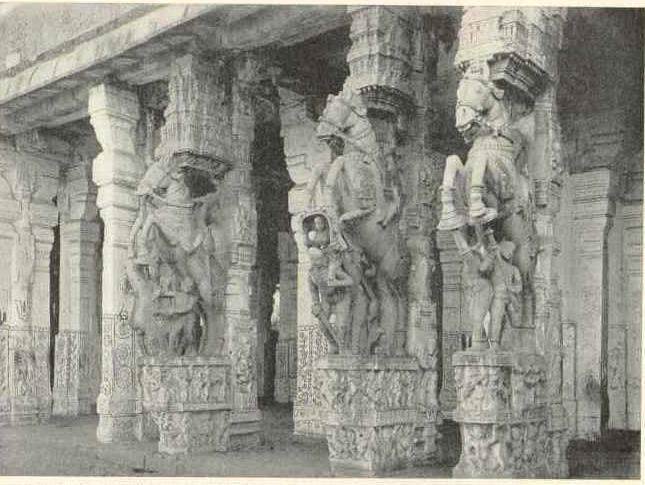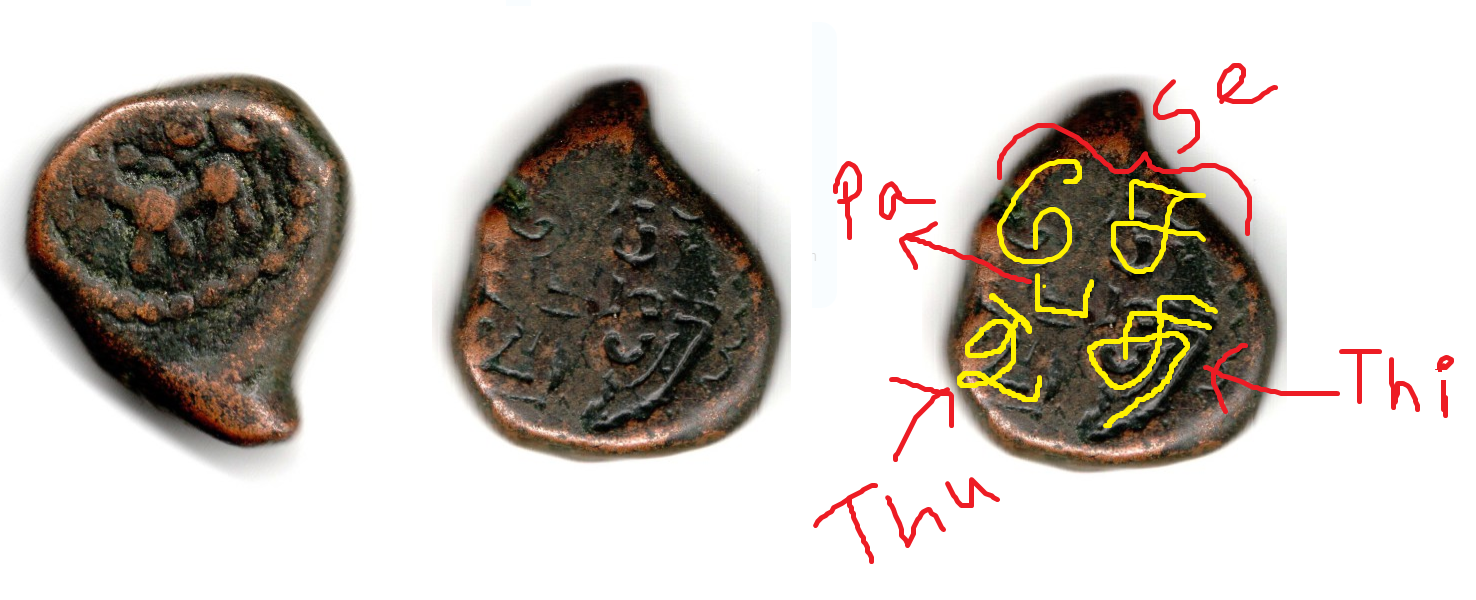|
Marava War Of Succession
The Marava War of Succession was the war of succession between, Vijayaraghunatha Sethupathi the heir apparent and eldest son of Raghunatha Kilavan and Tanda Thevar for the throne of Ramnad kingdom, also known as the Maravar Kingdom. The war of succession and the ensuing civil war lasted from 1720 to 1729 and resulted in the partitioning of the Ramnad kingdom reducing its power and influence. Prelude Raghunatha Kilavan, the founder of the Kingdom of Ramnad, died in 1710. He was an excellent soldier and his death left behind a huge void. Prior to his death, Kilavan had first nominated his illegitimate son, Bhavani Shankar and later, due to protests from the people, chose his younger son, Vijayaraghunatha Sethupathi to succeed him. Bhavani Shankar abided by the king's decision but an uneasy calm prevailed throughout Ramnad. Events Bhavani Shankar eventually revolted in 1720 and securing the help of the Thanjavur Maratha king Serfoji I and the Raja of Pudukkottai, invaded V ... [...More Info...] [...Related Items...] OR: [Wikipedia] [Google] [Baidu] |
Vijayaraghunatha Sethupathi
Vijayaraghunatha Sethupathi (died 1720) ruled from 1710 to 1720 the ''"Ramnad_estate#Ramnad, Ramnad Kingdom"'', also known as ''"Maravar Kingdom"''. He was an adopted son of Raghunatha Kilavan, the founder of the ''"Ramnad Kingdom"''. Sethupathi was the title granted by Thanjavur Nayak kingdom, Thanjavur Nayaks to his adoptive father Raghunatha Kilavan, and this title was retained by his descendants. Personal life According to a 1713 letter written by Christian missionary Martin, Vijayaraghunatha Sethupathi was the second son of Raghunatha Kilavan, the founder of the kingdom. Martin writes Vijayaraghunatha Sethupathi had two daughters: Sivagami Nachiar and Rajeswari Nachiar. The story is that both his daughters fell in love with the same man and the king got them both married to him. He also gave him a small portion of his kingdom to take care of. Reign Vijayaraghunatha Sethupathi became a king after his adoptive father Raghunatha Kilavan chose him as heir apparent on ... [...More Info...] [...Related Items...] OR: [Wikipedia] [Google] [Baidu] |
Thanjavur
Thanjavur (), also Tanjore, Pletcher 2010, p. 195 is a city in the Indian state of Tamil Nadu. Thanjavur is the 11th biggest city in Tamil Nadu. Thanjavur is an important center of South Indian religion, art, and architecture. Most of the Great Living Chola Temples, which are UNESCO World Heritage Monuments, are located in and around Thanjavur. The foremost among these, the Brihadeeswara Temple, is located in the centre of the city. Thanjavur is also home to Tanjore painting, a painting style unique to the region. Thanjavur is the headquarters of the Thanjavur District. The city is an important agricultural centre located in the Kaveri Delta and is known as the ''Rice bowl of Tamil Nadu''. Thanjavur is administered by a municipal corporation covering an area of and had a population of 290,720 in 2011. Roadways are the major means of transportation, while the city also has rail connectivity. The nearest airport is Tiruchirapalli International Airport, located away from ... [...More Info...] [...Related Items...] OR: [Wikipedia] [Google] [Baidu] |
Ramanathapuram District
Ramanathapuram District, also known as Ramnad District, is one of the 38 districts an administrative districts of Tamil Nadu state in southern India. The old Ramanathapuram District consists of Present day Virudhunagar and Sivagangai districts, it touches the Western ghats and bordered with the state of Kerala and east by Bay of Bengal. It was the largest district on that time. The town of Ramanathapuram is the district headquarters. Ramanthapuram District has an area of 4,123 km2. It is bounded on the north by Sivaganga District, on the northeast by Pudukkottai District, on the east by the Palk Strait, on the south by the Gulf of Mannar, on the west by Thoothukudi District, and on the northwest by Virudhunagar District. The district contains the Pamban Bridge, an east–west chain of low islands and shallow reefs that extend between India and the island nation of Sri Lanka, and separate the Palk Strait from the Gulf of Mannar. The Palk Strait is navigable only by ... [...More Info...] [...Related Items...] OR: [Wikipedia] [Google] [Baidu] |
Oxford University Press
Oxford University Press (OUP) is the university press of the University of Oxford. It is the largest university press in the world, and its printing history dates back to the 1480s. Having been officially granted the legal right to print books by decree in 1586, it is the second oldest university press after Cambridge University Press. It is a department of the University of Oxford and is governed by a group of 15 academics known as the Delegates of the Press, who are appointed by the vice-chancellor of the University of Oxford. The Delegates of the Press are led by the Secretary to the Delegates, who serves as OUP's chief executive and as its major representative on other university bodies. Oxford University Press has had a similar governance structure since the 17th century. The press is located on Walton Street, Oxford, opposite Somerville College, in the inner suburb of Jericho. For the last 500 years, OUP has primarily focused on the publication of pedagogical texts an ... [...More Info...] [...Related Items...] OR: [Wikipedia] [Google] [Baidu] |
Thanjavur Nayak Kingdom
The Thanjavur Nayak kingdom or Thanjavur Nayak dynasty were the rulers of Thanjavur in the 15th and 17th centuries. The Nayaks of the Balija social group, were originally appointed as provincial governors by the Vijayanagara Emperor in the 15th century, who divided the territory into Nayak kingdoms which were Madurai, Tanjore, Gingee and Kalahasthi. In the mid 15th century they became an independent kingdom, although they continued their alliance with the Vijayanagara Empire. The Thanjavur Nayaks were notable for their patronage of literature and the arts. A translation from '' Raghunathabhyudayam (p. 284)'', says this about Timma Nayak the father of Sevappa Nayak, the founder of the Tanjore Nayak in line: ''In the sathria caste born from the feet of Vishnu was born a king called Timma Nayak''.''Nayaks of Tanjore'', by V. Vriddhagirisan, p.26 The ''Mannaru'' (Vishnu) of the Mannargudi temple was their ''kula daivam'' (family deity). Origins of Nayak rule With the demise of the ... [...More Info...] [...Related Items...] OR: [Wikipedia] [Google] [Baidu] |
Sethupathi
The Sethupathis are a Tamil clan of the Maravar community native to the Ramanathapuram and Sivaganga district of Tamil Nadu, India. They were from the 17th century considered independent kings who ruled the Ramnad kingdom, also known as ''Maravar country''. The male rulers of Ramnathapuram also bore the title of "Sethupathi" or "protector of the bridge", which was first granted to the first Sethupathi Raghunatha Kilavan by the Thanjavur Nayaks, the bridge here referring to the legendary sacred Rama's Bridge (Adam's Bridge), while female rulers bore the title "Nachiyar". Among the seventy two poligars (feudal title of chieftains under Nayaka rulers) of the region, the Sethupathi stood first. This special position was conferred not based upon the revenue that his kingdom generated but because of his military prowess. Back in the beginning of the 18th century, the Sethupathi ruler could mobilize a considerable army, about 30,000 to 40,000 strong at short notice (one week). Und ... [...More Info...] [...Related Items...] OR: [Wikipedia] [Google] [Baidu] |
Ramnad Estate
The Kingdom of Ramnad or Ramnad estate was a permanently settled kingdom and later ''zamindari'' estate that existed in the Ramnad subdivision of the Madurai district and later Ramnad district of the erstwhile Madras Presidency in British India from 1601. It was ruled by the rajas also had the title of Sethupathi. Madurai Nayaks ruled the Ramnad area with the appointed chieftains between 14th to 16th century CE, and in 17th century CE the appointed governors expanded their power to establish "Ramnad Kingdom" which was also called as "Maravar Kingdom" by the British. In 1795 CE, after an heir dispute, they were reduced to the status of zamidari by the East India Company. After the independence of India in 1947 the estates were merged in the Union of India and in 1949 all rulers lost the ruling rights, privy purse was also finally abolished in 1971. The seat of administration was the town of Ramanathapuram. The Zamindari had its origins in the administrative area of Ramnad esta ... [...More Info...] [...Related Items...] OR: [Wikipedia] [Google] [Baidu] |
Tukkoji
Tukkoji Bhonsle (1677–1736) was the fourth Maratha ruler of Thanjavur, located in South India. He was from the Bhonsle dynasty and was the son of Ekoji I as well as the younger brother of Shahuji I and Serfoji I. Tukkoji ruled Thanjavur from 1728 to 1736. Reign Tukkoji succeeded his brother Serfoji I to the throne of Thanjavur on the former's death in 1728 and is believed to have reigned until 1736. However, the available records don't agree with each other. While the Tanjore Marathi inscriptions assign eight years to his rule the Madras Tamil manuscript assigns only 6 years. Tukkoji concluded the Marava war commenced by Serfoji I. Unlike his brother, however, he switched over to Bhavani Shankar's side and helped the latter attain the throne. Marathi inscriptions of this period record Tukkoji's aid to Meenakshi the Queen of Tiruchirapalli against the Palaiyakkarar who rose in revolt against her. He also fought against Chanda Sahib on the side of the Hindu rajas of South ... [...More Info...] [...Related Items...] OR: [Wikipedia] [Google] [Baidu] |
Raghunatha Kilavan
Sriman Hiranyagarbha Ravikula Raja Muthu Vijaya Raghunatha Raja Raghunatha Deva Kilavan Setupati (r. 1671–1710) was the first king of Ramnad Kingdom which is also known "Maravar Kingdom".Lists of Inscriptions, and Sketch of the Dynasties of Southern India By Robert Sewell, Archaeological Survey of Southern India He ruled from 1673 to 1708 and oversaw the growth of the feudal chieftainship of Ramnad into a powerful ''"Ramnad Kingdom"'' which is known as ''"Maravar Kingdom"''. He rescued the Nayak of Madurai from the tyranny of Rustam Khan and also successfully campaigned against the King of Thanjavur, who later ceded all his territories. It is recorded in the Sethupati copper plates that he belonged to the Surya kulam and Kashyap gothram. Personal life He fell in love with Kathali, a girl from the Kallar caste, later married her and then appointed his brother-in-law as the chief of Pudukottai for the military provided by tondaiman. He christened him ''Ragunatha Tondama ... [...More Info...] [...Related Items...] OR: [Wikipedia] [Google] [Baidu] |
Tanda Deva
Tanda may refer to: Places *Tanda, Ambedkar Nagar, India, a city and municipal board * Tanda (Bor), Serbia, a village *Tanda, Bengal, a historical medieval city *Tanda Dam and Lake, Khyber Pakhtunkhwa *Tanda Department, a department in Ivory Coast * Tanda, Egypt, a town *Tanda, Gujrat, Pakistan, a town * Tanda, Ivory Coast, a town in Ivory Coast * Tanda, Khyber Pakhtunkhwa, Pakistan, Town & Union Council * Tanda, Niger, a village and rural commune * Tanda, Raebareli, a village in Uttar Pradesh, India *Tanda, Rampur, India, a city and municipal board * Tanda, Russia, a rural locality (''selo'') in the Sakha Republic, Russia * Tanda, Bhopal, a village in India People *Nicola Tanda (1928–2016), Italian philologist, literary critic and writer * Dario Tanda (born 1995), Dutch-born footballer Other uses *Tanda (informal loan club), voluntary rotating loan associations * Tanda (milonga), a collection of songs in the same genre played by an orchestra *MV ''Tanda'', a coaster or coas ... [...More Info...] [...Related Items...] OR: [Wikipedia] [Google] [Baidu] |

.jpg)


